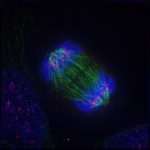
Chromatids
n., singular: chromatid
[ˈkɹəʊmətɪds]
Definition: The two strands joined together by a single centromere
Table of Contents
Chromatid Definition
Chromatids are found inside our cells. Chromatids are condensed chromosomes distinguishable during cell division. Those that are joined together at the centromere and carry identical copies of DNA molecules are called “sister chromatids” (as opposed to the non-sister chromatids, which are chromatids from another chromosome, and therefore carry different DNA molecules). Sister chromatids are like two halves of a puzzle piece. When cells divide, chromatids separate and go to different cells, making sure each new cell has the right instructions to grow and function properly.
The nucleus of eukaryotic cells contains chromosomes that are thread-like structures carrying genetic information in the form of DNA. Each chromosome is composed of two halves called chromatids. Chromatids are identical copies of a chromosome formed during DNA replication. They remain connected at the centromere until they separate during cell division, ensuring the accurate distribution of genetic material to daughter cells (Adlung, 2022).
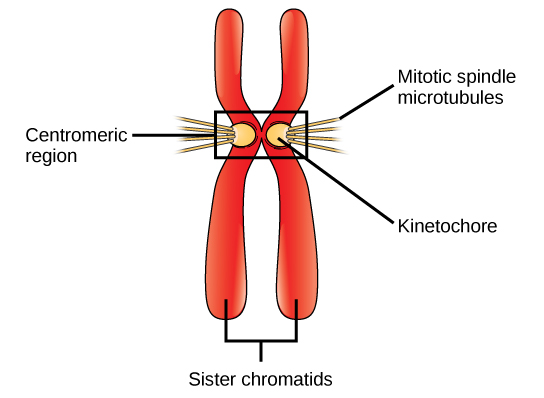
Chromatid Structure
Each chromatid consists of one DNA molecule that is tightly coiled and condensed. The DNA molecule is organized into repeating units called nucleosomes, which consist of DNA wrapped around histone proteins.
Prior to cell division, the chromosomes are not condensed and so the nucleosomes are visible. This gives the chromosomes a distinctive bead-like structure, which at this point the chromosome is referred to as chromatin. As the cell enters prophase, the chromosomes condense into chromatids and the nucleosomes become less distinguishable.
The condensation of DNA into chromatids helps to facilitate the efficient packaging of genetic material during cell division (Kallen, 202).
- Centromere: The centromere is a specialized region of the chromosome that serves as the attachment point for spindle microtubules during cell division. It is responsible for holding the sister chromatids together until they are ready to be separated. The centromere also plays a role in ensuring the equal distribution of genetic material between daughter cells.
- Kinetochore: The kinetochore is a protein structure located at the centromere of each chromatid. It serves as the attachment site for spindle microtubules, which are essential for the movement and separation of chromatids during cell division. The kinetochore helps to guide the proper alignment and separation of chromatids, ensuring accurate chromosome segregation.
- Chromatid Arms: Chromatids have two distinct regions called arms. The shorter arm is known as the p arm, while the longer arm is called the q arm. The arms of chromatids contain specific genetic loci and regions that play a role in gene expression and regulation.
- Telomeres: Telomeres are specialized structures located at the ends of chromatids. They consist of repetitive DNA sequences and associated proteins. Telomeres protect the integrity of the chromosomes and prevent the loss of genetic material during DNA replication and cell division. They also play a role in regulating cellular senescence and aging (Jeon, 2021).
Types Of Chromatids
There are two primary types of chromatids: sister chromatids and non-sister chromatids.
- Sister Chromatids: Sister chromatids are the two identical halves of a replicated chromosome that are held together at the centromere. They are produced during the S phase of the cell cycle when DNA replication occurs. Sister chromatids are genetically identical because they contain the same DNA sequence and carry the same set of genes. During cell division, sister chromatids separate and move to opposite poles of the cell, ensuring that each daughter cell receives an identical copy of the genetic material.
- Non-sister Chromatids: Non-sister chromatids refer to chromatids that come from different homologous chromosomes or different chromosomes altogether. They contain different genetic information and carry different sets of genes. Non-sister chromatids play a crucial role in meiosis, where they pair up during prophase I and undergo genetic recombination through a process called crossing over. Crossing over involves the exchange of genetic material between non-sister chromatids of the same chromosome, contributing to genetic diversity by creating new combinations of alleles.
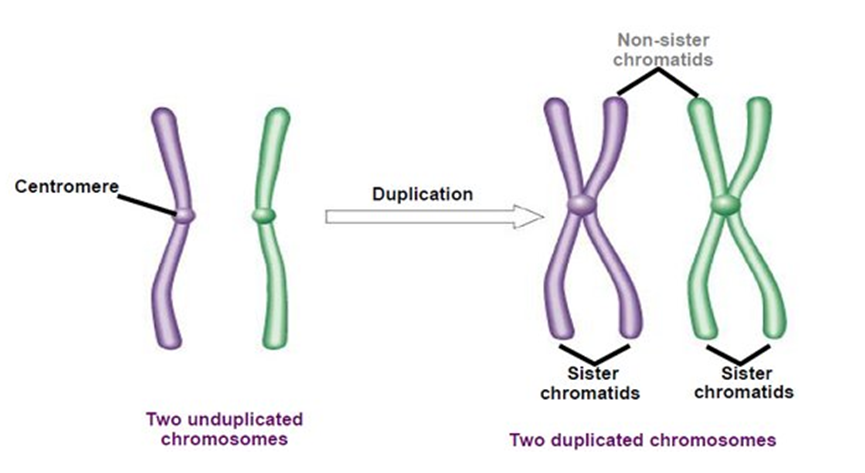
Watch this vid about chromatids and other related concepts:
Biology definition:
Chromatids are the condensed, replicated chromosomes palpable during cell division. In most eukaryotes, including humans, each chromosome is made up of two chromatids joined at the centromere. The two chromatids of a chromosome are formed during the interphase (synthesis phase) when the DNA in the chromatin is duplicated. In prophase, the chromatins condense and become distinct chromosomes. Each chromosome would have two strands joined by a kinetochore and either of the two strands would be called a chromatid. Each chromatid of a chromosome would contain half of the duplicated DNA; these chromatids having identical copies of the same DNA molecule are referred to as “sister chromatids”. During the last phases of cell division, the chromatids separate and move toward opposite poles of the cell. The division of the cell into two results in each daughter cell with a set of chromatids that eventually revert into the thin, less distinct chromatin, each containing a single strand of DNA.
Chromatids and Cell Division
Cell division is a fundamental process in all living organisms. It ensures the growth, development, and reproduction of cells. The cell cycle, which consists of interphase and mitosis (or meiosis in specialized cells), governs the orderly progression of cell division. During interphase, the cell prepares for division by growing, replicating its DNA, and synthesizing proteins. It is during this phase that the chromosomes are duplicated, resulting in the formation of two sister chromatids.
In mitosis, the replicated chromosomes condense and align along the center of the cell known as the metaphase plate. Each chromosome, composed of two sister chromatids, is attached to spindle microtubules, which extend from opposite spindle poles.
The spindle apparatus exerts forces on the chromatids, pulling them apart during anaphase (or anaphase II in meiosis), ensuring that each daughter cell receives an identical set of genetic information.
Eventually, the cell divides, and each daughter cell inherits one of the sister chromatids (Yadlapalli & Yamashita, 2013).
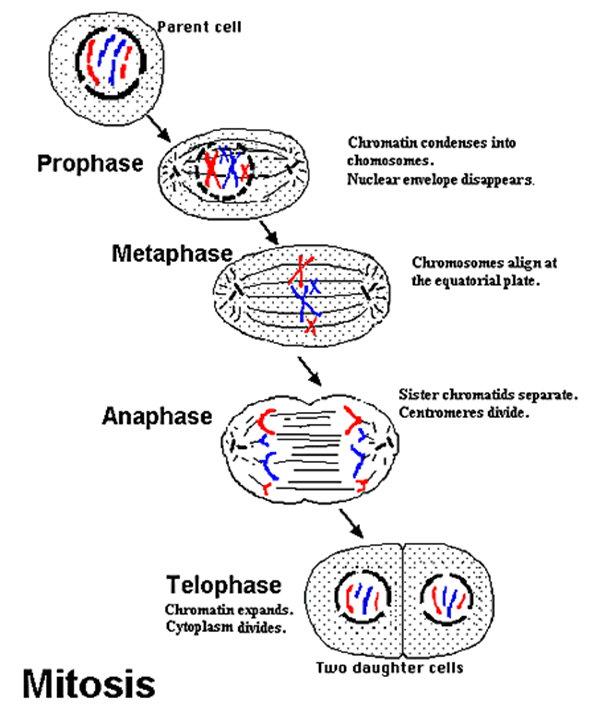
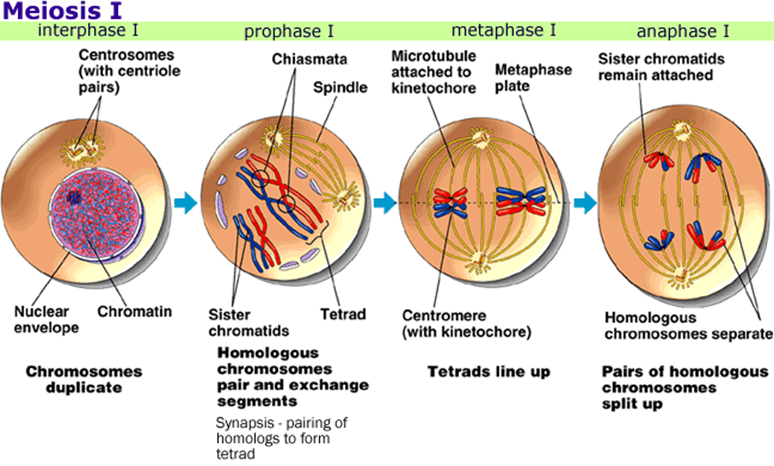
Homologous Chromosomes and Meiosis
In specialized cells involved in sexual reproduction, such as gamete cells, a slightly different type of cell division called meiosis occurs. Meiosis involves two rounds of division, referred to as meiosis I and meiosis II, respectively. This results in the production of haploid cells with half the number of chromosomes as the parent cell.
During meiosis I, homologous chromosomes, which are two chromosomes of the same type, one from each parent, pair up and exchange genetic material through a process called recombination. Importantly, each homologous chromosome consists of two sister chromatids. The separation of homologous chromosomes during anaphase I ensures that each daughter cell receives a single chromosome from each pair, thereby contributing to genetic diversity.
In meiosis II, similar to mitosis, the sister chromatids of each chromosome are separated. However, in mitosis, the parent cell would give rise to two diploid daughter cells whereas, in meiosis, the parent cell ultimately produces four haploid daughter cells. These haploid cells will eventually mature into gametes, such as eggs or sperm, each carrying a unique combination of genetic material.
Function Of Chromatids
Chromatids serve several important functions in cell division, contributing to the accurate transmission of genetic material to daughter cells. Here are the detailed functions of chromatids (Mehta et al., 2013):
- Transmission of Genetic Information: Chromatids are responsible for carrying and transmitting genetic information in the form of DNA. Each chromatid contains a complete copy of the DNA molecule, including all the genes necessary for the development and functioning of the organism.
- Sister Chromatid Cohesion: Prior to cell division, chromatids are held together by a protein complex known as cohesin. This cohesion ensures that the two sister chromatids remain closely associated until the appropriate time for separation. Cohesion is essential for the accurate distribution of genetic material during cell division.
- Maintenance of Chromosome Structure: Chromatids play a role in maintaining the structural integrity of chromosomes. During the cell cycle, chromosomes go through various stages of condensation and decondensation. Chromatids help to organize and compact the DNA into a more condensed structure, ensuring the efficient packaging of genetic material.
- Chromosome Segregation: The primary function of chromatids is to facilitate the proper segregation of genetic material during cell division. In mitosis, sister chromatids are separated during anaphase, with each daughter cell receiving one chromatid from each chromosome. This ensures that the genetic material is evenly distributed among the daughter cells.
- Contribution to Genetic Diversity: In meiosis, chromatids play a crucial role in generating genetic diversity. During meiosis I, homologous chromosomes pair up and exchange genetic material through a process called recombination. Each homologous chromosome consists of two sister chromatids and the separation of homologous chromosomes during anaphase I results in the formation of gametes with unique combinations of genetic material.
- Maintenance of DNA Integrity: Chromatids help protect the DNA molecule from damage during cell division. By closely associating the replicated DNA strands, chromatids minimize the exposure of the DNA to potential mutagens or enzymatic activities that could cause DNA damage.
- Facilitation of DNA Repair: If DNA damage occurs during the cell cycle, chromatids can contribute to DNA repair mechanisms. Sister chromatids provide a template for DNA repair processes, allowing damaged DNA to be accurately repaired by copying the undamaged DNA sequence.
Nondisjunction Errors
Non-disjunction is a type of error that can occur during cell division, specifically during the separation of chromatids or homologous chromosomes. In non-disjunction, the chromatids or homologous chromosomes fail to separate properly, leading to an unequal distribution of genetic material to daughter cells.
Non-disjunction can occur in both mitosis and meiosis, with different consequences.
- In mitosis, non-disjunction can result in cells with an abnormal number of chromosomes, a condition known as aneuploidy. Aneuploidy can lead to developmental abnormalities, cell death, or the formation of cancerous cells.
- In meiosis, non-disjunction can result in gametes with an abnormal number of chromosomes. When a sperm or an egg with an extra or missing chromosome participates in fertilization, it can lead to conditions such as Down syndrome (trisomy 21) or Turner syndrome (monosomy X). These genetic disorders can have profound effects on the development and functioning of individuals (Pena., 2023).
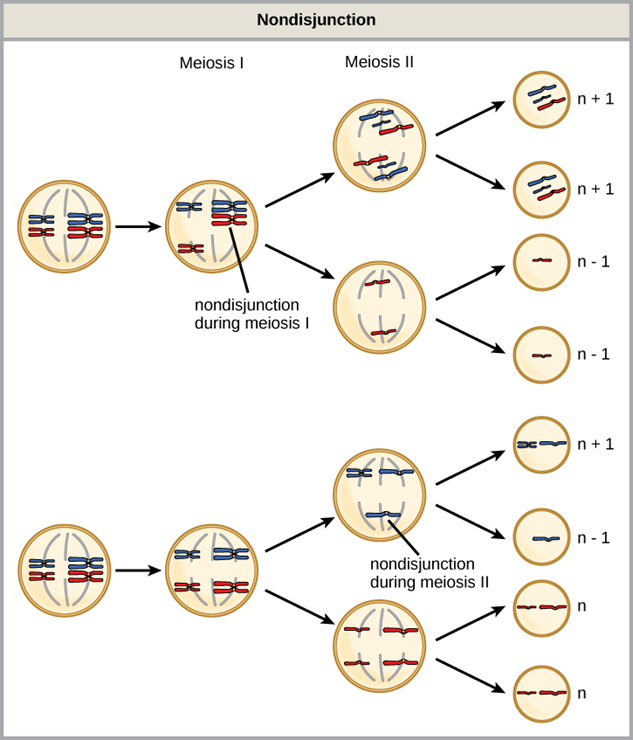
Types of Non-disjunction Errors
There are two main types of non-disjunction errors: autosomal non-disjunction and sex chromosome non-disjunction.
- Autosomal Non-disjunction: Autosomal non-disjunction involves the failure of homologous chromosomes to separate during either meiosis I or meiosis II. This results in the formation of gametes with an abnormal number of chromosomes. Examples include:
- Down syndrome (Trisomy 21): It occurs when there is an extra copy of chromosome 21. Instead of the usual two copies, individuals with Down syndrome have three copies of chromosome 21. This condition is characterized by distinct facial features, intellectual disability, and various medical complications.
- Edwards syndrome (Trisomy 18): It occurs when there is an extra copy of chromosome 18. Individuals with Edwards syndrome have three copies of chromosome 18 instead of the usual two. This condition leads to severe developmental abnormalities and medical complications, often resulting in a shortened lifespan.
- Patau syndrome (Trisomy 13): It occurs when there is an extra copy of chromosome 13. Individuals with Patau syndrome have three copies of chromosome 13 instead of the usual two. This condition causes severe intellectual disabilities, multiple physical abnormalities, and organ defects.
- Sex Chromosome Non-disjunction: Sex chromosome non-disjunction refers to the failure of sex chromosomes to separate during meiosis. It can lead to the production of gametes with an abnormal number of sex chromosomes. Examples include:
- Turner syndrome (Monosomy X): It occurs in females when one of the X chromosomes is missing or partially missing. Affected individuals typically have short stature, infertility, and certain physical features, such as a webbed neck and broad chest.
- Klinefelter syndrome (XXY): It occurs in males when they have an extra X chromosome, resulting in a total of 47 chromosomes instead of the usual 46. Individuals with Klinefelter syndrome may have reduced fertility, tall stature, and certain physical characteristics like enlarged breasts.
- Triple X syndrome (XXX): It occurs in females who have an extra X chromosome, resulting in a total of 47 chromosomes. Most females with triple X syndrome have no distinct physical features, but they may experience fertility issues and slight learning or behavioral difficulties.
Research on Non-Disjunction
Non-disjunction has been extensively studied to understand its causes and implications. One model organism that has contributed significantly to this research is budding yeast (Saccharomyces cerevisiae). Yeast cells undergo a simplified form of cell division, making them ideal for studying the underlying mechanisms of non-disjunction.
Studies in budding yeast have identified several proteins involved in the proper separation of chromatids and homologous chromosomes (Hesse et al., 2019). Mutations in these proteins can disrupt the accurate distribution of genetic material and lead to non-disjunction events. By studying these proteins and their interactions, researchers gain valuable insights into the mechanisms and potential treatments for non-disjunction-related genetic disorders.
By studying these proteins and their interactions, researchers gain a deeper understanding of the underlying processes of non-disjunction and potential avenues for developing treatments for genetic disorders associated with these errors.
Advancements in cell biology and genetics continue to expand our knowledge of chromatids, their function, and the consequences of non-disjunction. Understanding the intricate processes that govern chromatid separation is essential for elucidating the complexities of genetic inheritance and improving our ability to diagnose and treat genetic disorders. By furthering our understanding of chromatids, researchers are paving the way for potential therapeutic interventions and strategies to prevent or mitigate the consequences of non-disjunction.
Did you know…?
… that each human body cell contains 46 chromosomes, which means 23 pairs?
These chromosomes consist of two chromatids each, joined together at a central region called the centromere. During cell division, the chromatids separate and move to opposite ends, ensuring that each new cell receives the correct genetic information. This process, known as mitosis, is vital for growth, repair, and maintaining the body’s functions.
Here’s another interesting fact!
Not all eukaryotes have chromosomes that are made up of just two chromatids!
Fruit flies (Drosophila melanogaster), for instance, have polytene chromosomes, which are a type of chromosome with numerous copies (“chromatids”) as a result of repeated rounds of DNA replication without separation. Polytene chromosomes are commonly seen in the salivary glands of Drosophila larvae and play a role in gene regulation.
Take the Chromatids – Biology Quiz!
References
- Adlung, L. (2022). DNA & RNA & Associated Proteins. In Cell and Molecular Biology for Non-Biologists: A short introduction into key biological concepts (pp. 11-23). Berlin, Heidelberg: Springer Berlin Heidelberg.
- Hesse, S., Zelkowski, M., Mikhailova, E. I., Keijzer, C. J., Houben, A., & Schubert, V. (2019). Ultrastructure and dynamics of synaptonemal complex components during meiotic pairing and synapsis of standard (A) and accessory (B) rye chromosomes. Frontiers in Plant Science, 10, 773..
- Jeon, H. J., & Oh, J. S. (2021). TRF1 Depletion Reveals Mutual Regulation Between Telomeres, Kinetochores, and Inner Centromeres in Mouse Oocytes. Frontiers in Cell and Developmental Biology, 9, 749116.
- Pena, S. D. (2023). Advances of aneuploidy research in the maternal germline. Nature Reviews Genetics, 1-1.
- Kallen, A. N. (2020). Basic genetics: mitosis, meiosis, chromosomes, DNA, RNA, and beyond. In Human Reproductive Genetics (pp. 3-16). Academic Press.
- Mehta, G. D., Kumar, R., Srivastava, S., & Ghosh, S. K. (2013). Cohesin: functions beyond sister chromatid cohesion. FEBS letters, 587(15), 2299-2312.
- Yadlapalli, S., & Yamashita, Y. M. (2013). Chromosome-specific nonrandom sister chromatid segregation during stem-cell division. Nature, 498(7453), 251-254.
©BiologyOnline.com. Content provided and moderated by Biology Online Editors.





